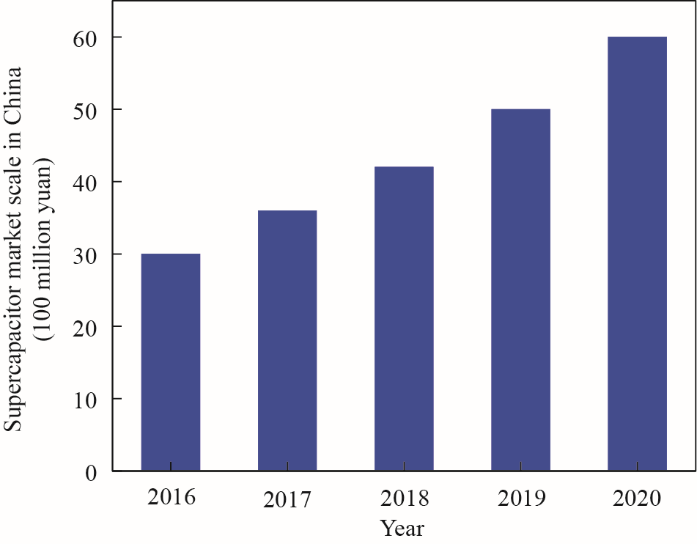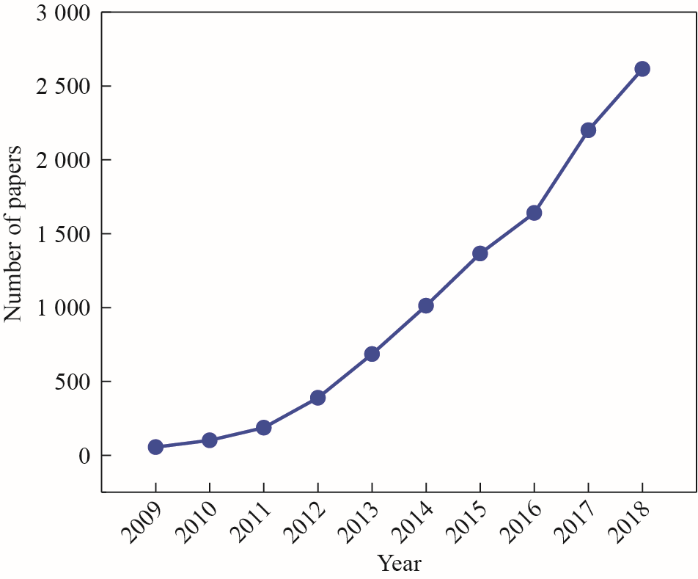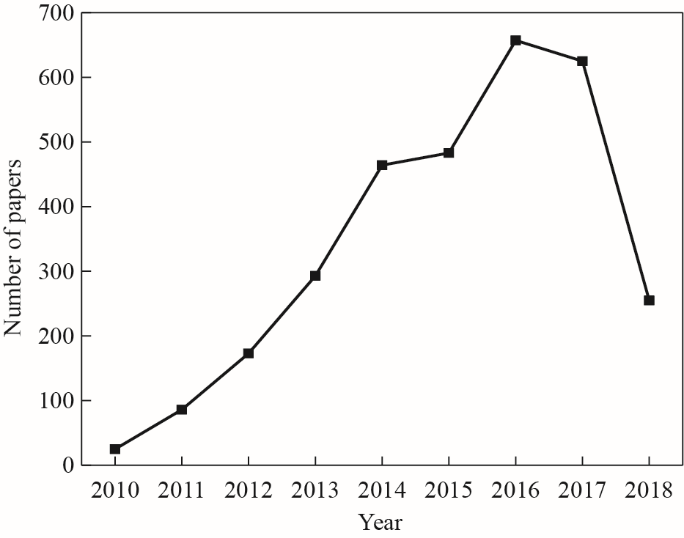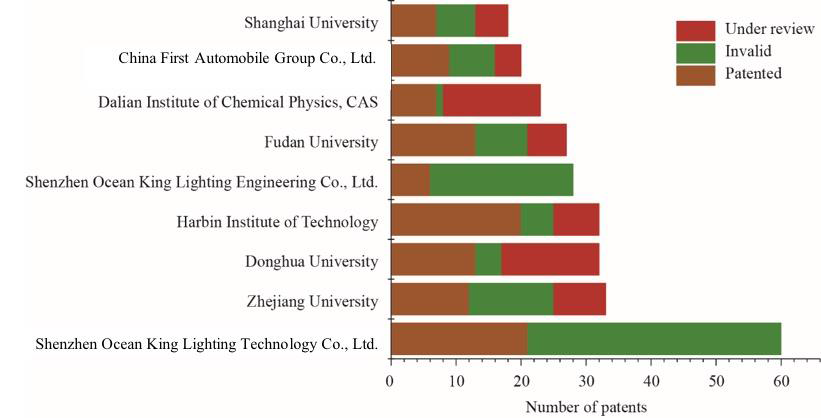《1 Introduction 》
1 Introduction
The rapid development of the global economy and the consumption of traditional energy sources has led to the deterioration of both the ecological environment and the sustainable development of human society. The development of the sustainable energy industry has become an important measure to solve the energy crisis and protect the environment. Developing new energy storage devices with high efficiency is one of the key steps in the development of the sustainable energy industry and has become an urgent task for our society. Among new energy storage devices, supercapacitors combine the advantages of both traditional capacitors and electrochemical batteries. They are widely applicable in electric vehicles, power grid energy storage, mobile communications, consumer electronics, medical devices, national defense, and military equipment, to name a few. At present, the research focus of supercapacitors is on improving their energy and power densities, as well as developing electrode materials with high specific surface area, conductivity, and structural stability.
Because of its unique chemical structure, graphene has a large specific surface area, excellent electronic conductivity and thermal conductivity, and high carrier mobility and mechanical strength. Furthermore, thanks to its excellent comprehensive properties, graphene is considered an ideal electrode material for supercapacitors with high energy density and high power density. It plays an irreplaceable role in increasing the specific energy and power density and prolonging the service life of supercapacitors as a result of, among other properties, its high specific surface area, crystalline structure, and high conductivity. However, its theoretical capacity is low, and stacking readily occurs during electrode preparation, which leads to a decrease in the specific surface area and ionic conductivity. Graphene stacking, high ion transfer resistance, low porosity, and small effective specific surface area are technical problems that urgently need to be solved for the development of graphene-based supercapacitors. Optimizing the preparation method and modifying or compounding graphene with other materials are effective ways to solve such problems.
Achieving efficient preparation of graphene-based supercapacitors with high specific capacitance, high power performance, and stable and long cycle life is a key problem to be solved by researchers in academia and industry. In this paper, we briefly expound the problems faced in the development of the supercapacitor industry and the key role of graphene in solving these problems. Furthermore, the development and research status of graphene-based supercapacitors are briefly analyzed, and the key problems and challenges in the future development and application of graphene-based supercapacitors are discussed.
《2 Development status of graphene-based supercapacitors》
2 Development status of graphene-based supercapacitors
《2.1 Supercapacitor 》
2.1 Supercapacitor
A supercapacitor, also known as an electrochemical capacitor, is a new energy storage device that combines the properties of traditional capacitors and batteries. Depending on the energy storage mechanism, supercapacitors can be divided into chemical double-layer capacitors and Faraday pseudocapacitors. Chemical double-layer capacitors store energy by ion adsorption in electrodes/electrolytes, and Faraday pseudocapacitors store energy utilizing both ion adsorption and ion oxidation-reduction reactions in electrodes/electrolytes [1]. Based on their energy storage principle, supercapacitors have excellent power and cycle performances. Usually, they can be used hundreds of thousands of times under a charge–discharge current density of 100 C (C represents the charge–discharge ratio, e.g., charging time of 0.01 h at 100 C). In addition, compared with traditional capacitors, which store energy by electrostatic adsorption, the specific capacity of supercapacitors is much higher. By comparing the electrochemical performances of supercapacitors with those of batteries and traditional capacitors, as shown in Table 1, as energy storage devices, it is clear that supercapacitors have significant advantages over batteries with respect to power density, charge–discharge rate, and cycle capacity, and over traditional capacitors regarding energy density. From small-capacity special-energy storage to large-scale power storage and from single-energy storage to hybrid-energy storage systems composed of storage batteries, lithium batteries, or fuel cells, supercapacitors show unique advantages. Supercapacitors are applied in industries (e.g., in renewable energy generation systems, distributed power grid systems, energy-saving buildings, industrial energy-saving emission reduction, intelligent instruments, and power tools), consumer electronics (e.g., motion control and toys), communications (e.g., digital products), medical devices, national defense equipment (e.g., high-power weapons), transportation (e.g., electric vehicles and hybrid electric vehicles), and more. However, supercapacitors cannot yet completely replace batteries in power storage systems. The energy density per unit volume still needs to be improved and remains an area of focus in the field of supercapacitors. To this end, electrode materials with high specific surface area, high conductivity, and structural stability are being developed and investigated [3−5].
《Table 1. 》
Table 1. Comparison of electrochemical performance of three energy storage devices [1,2]

Note: s–min represents time scales ranging from seconds to minutes.
《2.2 Graphene-based supercapacitors 》
2.2 Graphene-based supercapacitors
Graphene has excellent mechanical, thermal, and electrical properties and meets the supercapacitor requirements of high-energy-density and high-power-density electrode materials. It is thus considered to be an ideal electrode material for supercapacitors [6]. The Strategic Alliance of Technological Innovation for China’s Graphene Industry predicts that the market size of graphene-based supercapacitors will reach nearly RMB 600 million yuan by 2020, accounting for 10% of the global market share of supercapacitors, as shown in Fig. 1.
《Fig.1》

Fig. 1. Forecast of supercapacitors market scale in China from 2016 to 2020.
At present, research on graphene-based supercapacitors is mostly focused on the chemical modification of the graphene microchip itself to increase its specific surface area, which is conducive to the entry of the electrolyte and further improves the electrochemical performance of the supercapacitor. According to the search results of ScienceDirect under the ELSEVIER Publishing Group (retrieval date: October 3, 2018), the number of international papers on graphene-based supercapacitors has increased from 55 in 2009 to 2201 in 2017, as shown in Fig. 2, showing a significant growth trend. At the same time, the number of papers on basic research in international academic papers makes up more than 80% of all graphene-based supercapacitor-related papers, which indicates that global research is still at the basic stage and still focuses on the modification and optimization of graphene electrode materials.
《Fig.2》

Fig. 2. Annual distribution of the number of international papers published on graphene-based supercapacitors.
The number of papers published on graphene-based supercapacitors in China (according to a search of CNKI) has experienced a similar growth trend in recent years, as shown in Fig. 3. Since a Nobel Prize for graphene was awarded in 2010, graphene has gained the public’s attention and has rapidly become one of the foci of scientific research. At the same time, the practical application of graphene in supercapacitors has been highly influential and enthusiastically investigated. Chinese scholars have followed the research trend, and a large number of researchers have worked on practical applications of graphene, promoting the rapid growth of related research papers. However, the papers are primarily published by prestigious universities and research institutes, such as Tsinghua University, Chinese Academy of Sciences University, and Tianjin University. Research on graphene-based supercapacitors mostly covers the topics of supercapacitors, graphene, composite materials, specific capacity, electrode materials, and electrochemical properties. This shows that the current research focus is mostly on the rational utilization of the excellent properties of graphene to solve technical bottlenecks in supercapacitor development, such as developing and preparing electrode materials with excellent performance, improving their comprehensive electrochemical performance, and promoting their industrial development process. Statistical analysis of the overall research level of graphene-based supercapacitors has shown that researchers in China primarily focus on engineering technology, basic and applied research, and technical guidance for industries, as shown in Fig. 4.
《Fig.3》

Fig. 3. Annual distribution of the number of papers on graphene-based supercapacitors published in China.
《Fig.4》

Fig. 4. Hierarchical distribution of Chinese papers related to graphene-based supercapacitors.
With the continuous promotion of the industrialization of graphene-based supercapacitors and the increasing policy support of the State for this industry, graphene has become part of the national macro-strategic layout, and its practical application to supercapacitors has also been strongly supported. The National Natural Science Foundation of China has also launched a number of major research projects to promote the commercial application process of graphene and graphene-based supercapacitors. According to data from the National Science Foundation Sharing Service Network, 338 national projects directly related to graphene-based supercapacitors have been supported, accounting for 43.17% of the total 783 national projects related to graphene. This shows that basic research on the application of graphene in supercapacitors is highly valued and strongly supported at the national level.
From a search of the Global Patent Search System of Chofn.com, it was found that there are more than 2200 global patents for graphene-based supercapacitors. Relevant patent applications began in 2009. After two years of development, the number of global patents began to significantly increase in 2012, reaching a maximum of 472 in 2016. Although the number of patent applications worldwide has declined in the past two years, it remains relatively high, as shown in Fig. 5. This indicates that the application of graphene in supercapacitors has been widely achieved since 2009 and has been increasing rapidly around the world. After nearly ten years of basic research, the related technology of graphene-based supercapacitors has matured somewhat. Fig. 6 shows the results of the analysis of the number of patents related to graphene-based supercapacitors globally (data source: Chofn World Patent Database; retrieval date: October 3, 2018). As shown in the figure, the top three countries/organizations in terms of number of patent applications are the United States (875 cases, accounting for 38.26%), China (518 cases, accounting for 22.65%), and the World Intellectual Property Organization (491 cases, accounting for 21.47%). South Korea (120 cases, accounting for 5.25%) and the European Patent Office (104 cases, accounting for 4.55%) ranked fourth and fifth, respectively. The worldwide increase in patent applications related to graphene-based supercapacitors is closely related to the increase in project investment and strategic deployment of graphene-based supercapacitors, which reflects the confidence of local governments in this technology. The distribution of patent applications around the world shows that the United States, China, and Korea have provided extensive input regarding graphene-based supercapacitors and strengthened human investment in this research field. The rapid development of graphene-based supercapacitors is closely related to the government’s policy support and strategic prospective layout.
《Fig.5》

Fig. 5. Annual distribution of global graphene-based supercapacitor patents
《Fig.6》

Fig. 6. Top 10 countries/organizations for patent quantity with respect to graphene-based supercapacitors.
From a search and analysis of PATEXPLORER, the authoritative patent database of Baiteng Technology Co., Ltd., the top four domestic patent applicants for graphene-based supercapacitors are Shenzhen Ocean King Lighting Technology Co., Ltd. (119 persons), Zhejiang University (117 persons), Donghua University (84 persons), and Harbin University of Technology (82 persons) (data source: www.patexplorer.com; retrieval date: Oct. 1, 2018). Ocean King Lighting began its application in graphene preparation, doping technology, and composite materials and supercapacitors in 2012. Now, it is one of the main graphene-based supercapacitor patent applicants [7]. Five of the top eight institutions in terms of patent applications for graphene-based supercapacitors in China are universities and research institutes (data source: www.patexplorer.com; retrieval date: Oct. 1, 2018). This also shows that research on graphene-based supercapacitors in China is still at a basic level and needs further development before reaching the commercial market. Moreover, a large proportion of patents on graphene-based capacitors in China is invalid, as shown in Fig. 7 (data source: www.patexplorer.com; retrieval date: Oct. 1, 2018). This indicates the low quality of patents in China. In addition, the invalidation rate of graphene-based supercapacitor-related patents is high, primarily because the direction of their market development is not clear. With the emergence and development of new technologies, some patents may lose their market value, which may prompt the relevant patent holders to choose to withdraw their patents and not pay patent fees to protect them.
《Fig.7》

Fig. 7. Legal status of patent applications from the top 10 institutions in China.
With the vigorous support of national policies and enterprises regarding the research, development, and application of graphene, the research and development of graphene-based supercapacitors has grown by leaps and bounds and has gradually been oriented toward the market. The Annual Report on Graphene Development in China from 2016 to 2017 points out that the development and application of graphene in supercapacitors are expected to be commercialized within 3 to 5 years. In October 2016, Changzhou Cube Energy Technology Co., Ltd. solved the problem of graphene slurry, which is difficult to produce and deposit, by improving the coating process and designing the non-standard parts of the coating machine, braking the bottleneck of mass production. Graphene-based supercapacitors produced by this technology are environmentally friendly, non-flammable, non-explosive, can be charged and discharged millions of times, and exhibit low temperature resistance. In July 2017, Zapgo Co., Ltd. and Zhuzhou Cube New Energy Technology Co., Ltd. cooperated in the development of “carbon-ion” graphene-based supercapacitors. While ordinary batteries can be charged in a few hours, carbon-ion supercapacitors can be charged in three to five minutes. In November 2017, Ningbo Zhongche New Energy Technology Co., Ltd. and Ningbo Institute of Material Technology and Engineering at the Chinese Academy of Sciences jointly developed a highenergy-density lithium-ion supercapacitor using graphene-modified-cathode composite materials and a graphenemodified-composite conductive agent, which solved the key technical problems of unstable structure and low electrode density of lithium-ion capacitors. This shows that the technology level of lithium-ion graphene-based supercapacitors in China has reached the international level. In May 2018, Tsinghua University and Jiangsu Zhongtian Polytron Technologies Inc. jointly achieved the phased results of “high voltage super capacitor technology based on graphene ionic liquid aluminum foam collector.” For the first time in China, the preparation technology of all-aluminum foam fluids was mastered, and many processing problems related to graphene high-performance nanomaterials for supercapacitors were solved. Thus, China’s high-voltage supercapacitor technology has also reached the level of the world’s leaders.
《3 Challenges in the development of graphene-based supercapacitors and suggestions for future development 》
3 Challenges in the development of graphene-based supercapacitors and suggestions for future development
Although the overall development is mature and a series of breakthroughs have been made, there are still problems to be solved in the graphene industry that restrict its practical application. More specifically, the market-oriented process of graphene-based supercapacitors is still facing various difficulties and challenges. It is now necessary to understand how to effectively transform the research results into viable products. The main challenges in the future development of graphene-based supercapacitors can be summarized as follows: (1) development of economical and controllable methods for mass production of graphene materials with controllable quality, area, and number of layers; (2) optimization and control of electrode and capacitor structures in the production process and safe installation of supercapacitors in later stages; and (3) agglomeration of graphene sheets without restricting the performance of graphene-based electrode materials.
Considering the development status, key problems, and market demand of graphene-based supercapacitors, we believe that the future development of graphene-based supercapacitors will require a focus on the following aspects:
(1) In view of the great differences in the physical, mechanical, and chemical properties of graphene-based electrode materials with different structures, the supercapacitive energy storage performance will be affected. By studying the relationship between the structure of graphene-based electrode materials and their electrochemical performances, the best conditions to prepare electrodes with stable structure and excellent electrochemical performance should be found.
(2) The material structure and material-interface interactions of graphene nanocomposite electrodes have an important influence on the electrochemical Faraday processes. Clarifying the reaction mechanism of interface interactions is very important for accelerating and optimizing the practical application of graphene in Faraday pseudocapacitors.
(3) In recent years, flexible electronic devices have undergone rapid development, and flexible, deformable energy storage devices are urgently needed to provide power support. Because of the excellent performance of graphene, graphene-based supercapacitors show unique advantages in the field of flexible electronic devices. Understanding how to optimize the structure of graphene-based supercapacitors and their electrodes is key for future developments.
In addition, government departments should act as a bridge for accelerating the marketization of graphene-based supercapacitors by connecting scientific research institutes, industrial experts, enterprises, and consumer markets. At the same time, government policy regulation plays an irreplaceable role in regulating the development of the graphene-based supercapacitor market and has a far-reaching impact on the future advancement of this technology. Policy regulation and support is the accelerator that can promote the development of graphene-based supercapacitors from laboratory to market applications and mass production.
《4 Conclusions 》
4 Conclusions
Given the global energy crisis and the erosion of the environment, research on new energy storage devices is very important. Graphene is an excellent electrode material for developing supercapacitors with high energy density, high power density, and long life that have broad market prospects and great strategic significance. China has become one of the most active countries in the research and application of graphene. Governments at all levels also show great interest in graphene and have established a “government−industry−university−research−funding” cooperation mechanism for collaborative innovation among governments, research institutions, R&D departments, and application enterprises. However, graphene-based supercapacitor-related technologies are still concentrated primarily in universities and institutes, and industrialization will require a long time. The State should help provide connections between universities and enterprises and vigorously promote the industrialization of graphene-based supercapacitors.














 京公网安备 11010502051620号
京公网安备 11010502051620号




